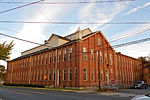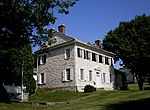The Lehigh Crane Iron Company, later renamed Crane Iron Company, was a major ironmaking firm in the Lehigh Valley from its founding in 1839 until its sale in 1899. It was based in Catasauqua, Pennsylvania, and was founded by Josiah White and Erskine Hazard, who financed its development through their Lehigh Coal & Navigation Company, which promoted the then-novel technique of smelting iron ore with anthracite coal. This was an important cost and energy savings technique, credited with eliminating the need for either expensive charcoal or coke producing processes and transport costs that proved central to the acceleration of the American industrial revolution.The new company was named Crane in recognition of George Crane, a British foundry owner whose kind understanding and support backed their desire to hire away his foundry's long time superintendent, ironmaster David Thomas, who had achieved regular successes in employing the new hot blast process and successfully worked out necessary additional methods to not only smelt iron, but produce fine quality cast iron and pig iron ready to make steel. These results positioned Crane's company's strongly to dominate British steel and iron manufacturing for decades. Crane was grateful, so with a younger Thomas assistant already on hand, allowed Thomas his big chance for fortune. LC&CN's Hazard not only hired him and paid his expenses to come to America and set up an ironworks using the new technique, but made him a partner in the enterprise in agreement of 31 December 1838.
By late winter, LC&NC was seeking suitable real estate, with water power and access to iron ores. Suitable acres were available a few miles below the Lehigh Gap in Northampton County. The company put its first furnace into blast in 1840, and quickly gained a reputation for efficiency and ironmaking prowess among the many furnaces that now sprang up in the Lehigh Valley. Over the next several decades, Crane Iron developed an extensive portfolio of assets, buying mines in the Lehigh Valley and in northern New Jersey, and taking over many of the smaller iron furnaces in the region. Crane Iron also financed the building of railroads in the area to haul limestone and iron ore to its furnaces.
As the merchant pig iron business began to decline, Crane Iron sold off much of its railroad interests in 1896. In an effort to revive Eastern iron mining in the face of competition from Minnesota, Crane took part in Thomas Edison's attempts to develop a magnetic ore beneficiation process. However, Edison's experiments proved uneconomical and the Edison Ore-Milling Company was a failure. In 1899, Crane Iron was sold to the Empire Steel and Iron Company, a conglomerate of Eastern and Southern iron furnaces. The Crane Works, as the company's plant was now known, last made iron in 1930, and the plant was torn down in 1932.









